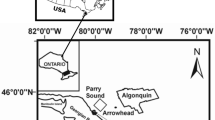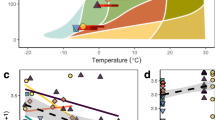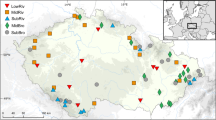Abstract
Magellanic Sub-Antarctic streams run through steep, low-altitude mountainous gradients characterized by a topography that supports a mosaic of evergreen, mixed, and deciduous forests, peat lands, and scrublands. Here, the macroinvertebrate fauna and their ecological interactions are poorly known. This study linked the distribution, community composition, and functional feeding structure of benthic macroinvertebrates with physicochemical and thermal patterns along the altitudinal gradient of a Magellanic Sub-Antarctic watershed. Invertebrates were collected during the austral summers of 2008, 2009, and 2010 at five different altitudes. Our results indicate that benthic macroinvertebrate community distributions are predominantly affected by temperature and certain species show distribution restrictions through the altitudinal gradient studied. Temperature profiles indicate that this Sub-Antarctic watershed is characterized by a sharp thermal gradient, in which cumulative degree-days (°C) per year sharply increase through a relatively short altitudinal gradient (0–600 m above sea level). With the results from this study, we can now study thermal tolerances of altitude-restricted species or project changes in their distributions and voltinism patterns according to climate change scenarios. Ecosystems at higher latitudes and altitudes are experiencing some of the fastest rates of warming on the planet, and Magellanic Sub-Antarctic watersheds could be considered as “sentinel systems,” providing early warning of wider scale change.









Similar content being viewed by others
References
Anderson CB, Rosemond A (2007) Ecosystem engineering by invasive exotic beavers reduces in-stream diversity and enhances ecosystem function in Cape Horn, Chile. Oecologia 154:141–153. doi:10.1007/s00442-007-0757-4
Armesto J, Rozzi R, Smith-Ramirez C, Arroyo MT (1998) Conservation targets in South American temperate forests. Science 282:1271–1272. doi:10.2307/2897286
Contador TA (2011) Benthic macroinvertebrates of temperate, sub-Antarctic streams: effects of altitudinal zoning and temperature on the phenology of aquatic insects associated Róbalo river, Navarino Island (55°S), Chile. Dissertation, University of North Texas
Contador TA, Kennedy JH, Rozzi R (2012) The conservation status of South American aquatic insects in the literature. Biodivers Conserv 21:2095–2107. doi:10.1007/s10531-012-0299-x
Convey P, Stevens MI (2007) Antarctic biodiversity. Science 317:1877. doi:10.1126/science.1147261
Crawley MJ (2007) The R book. Wiley, England
Domínguez E, Fernández HR (2009) Macroinvertebrados bentónicos Sudamericanos: Sistemática y Biología, 2nd edn. Fundación Miguel Lillo, Tucumán
Harrelson C, Rawlins CL, Potyondy JP (1994) Stream channel references sites: an illustrated guide to field technique. USDA Forestry Service, Fort Collins
Hassan R, Scholes R, Ash N (2005) Millenium ecosystem assessment. Ecosystems and human well-being: current state and trends. Island Press. http://www.unep.org/maweb/documents/document.766.aspx.pdf. Accessed 13 March 2013
Hauer RF, Baron JS, Campbell DH, Fausch KD, Hostetler W, Leavesley GH, Leavitt PR, McKnight DM, Stanford JA (1997) Assessment of climate change and freshwater ecosystems of the Rocky Mountains, USA and Canada. Hydrol Process 11:903–924. doi:10.1002/(SICI)1099-1085(19970630)
Hauer RF, Stanford JA, Giersch JJ, Lowe WH (2000) Distribution and abundance patterns of macroinvertebrates in a mountain stream: an analysis along multiple environmental gradients. Verh Int Verein Limnol 27:1485–1488
Hulton NRJ, Purves RS, McCulloch RD, Sugden DE, Bently MJ (2002) The last glacial maximum in southern South America. Quat Sci Rev 21:233–241. doi:10.1016/S0277-3791(01)00103-2
Jacobsen D (2004) Contrasting patterns in local and zonal family richness of stream invertebrates along an Andean altitudinal gradient. Freshw Biol 49:1293–1305. doi:10.1111/j.1365-2427.2004.01274.x
Kampstra P (2008) Beanplot: a boxplot alternative for visual comparison of distributions. J Stat Softw 28: Code Snippet 1. http://www.jstatsoft.org/. Accessed 5 April 2012
Krosch MN, Baker M, Mather PB, Cranston PS (2011) Systematics and biogeography of the Gondwanan Orthocladiinae (Diptera: Chironomidae). Mol Phylogenet Evol 59:458–468. doi:10.1016/j.ympev.2011.03.003
McCulloch RD, Clapperton CM, Rabassa J, Currant AP (1997) The glacial and post-glacial environmental history of Fuego-Patagonia. In: McEwan I, Borrero LA, Prieto A (eds) Patagonia: natural history, prehistory and ethnography. Princeton University Press, Princeton, pp 12–31
Merritt RW, Cummins K (2007) Trophic relations of macroinvertebrates. In: Hauer FR, Lamberti GA (eds) Methods in stream ecology. Academic Press, San Diego, pp 585–610
Merritt RW, Cummins K, Berg MB (2008) An introduction to the aquatic insects of North America. Kendall/Hunt Publishing Company, Dubuque
Miserendino ML, Pizzolon LA (2000) Macroinvertebrates of a fluvial system in Patagonia: altitudinal zonation and functional structure. Archiv Fur Hydrobiol 150:55–83
Miserendino ML, Pizzolon LA (2003) Distribution of macroinvertebrate assemblages in the Azul-Quemquemtreu river basin, Patagonia, Argentina. New Zeal J Mar Fresh 37:525–539
Mittermeier RA, Mittermeier CG, Brooks T, Pilgrim JD, Konstant WR, Fonseca GA, Kormos C (2003) Wilderness and biodiversity conservation. Proc Natl Acad Sci USA 100:10309–10313. doi:10.1073/pnas.1732458100
Pisano E (1980) Distribución y características de la vegetación del archipiélago del Cabo de Hornos. An Inst Patagonia Ser Cien Nat 11:192–224
Porter C, Santana A (2003) Rapid 20th century retreat of Ventisquero Marinelli in the Cordillera Darwin icefield. An Inst Patagonia Ser Cien Nat 31:17–26
R.app GUI 1.65 (6833 Snow Leopard build), S. Urbanek & H.-J. Bibiko, © R Foundation for Statistical Computing, 2014
Rozzi R, Anderson CB, Pizarro JC, Massardo F, Medina Y, Mansilla A, Kennedy JH, Ojeda J, Contador TA, Morales V, Moses K, Poole A, Armesto JJ, Kalin MT (2010) Field environmental philosophy and biocultural conservation at the Omora Ethnobotanical Park: methodological approaches to broaden the ways of integrating the social component (“S”) in Long-Term Socio-Ecological Research (LTSER) Sites. Rev Chil Hist Nat 83:27–68. doi:10.4067/S0716-078X2010000100004
Rozzi R, Armesto JJ, Gutiérrez J, Anderson CB, Massardo F, Likens G, Poole A, Moses K, Hargrove G, Mansilla A, Kennedy JH, Willson M, Jax J, Jones C, Callicott JB, Kalin MT (2012) Integrating ecology and environmental ethics: earth stewardship in the southern end of the Americas. Bioscience 628:1226–1236. doi:10.1525/bio.2012.62.3.4
Snyder RL, Spano D, Duce P, Cesaraccio C (2001) Temperature data for phenological models. Int J Biometeorol 45:178–183. doi:10.1007/s004840100103
Sweeney BW, Jackson JK, Newbold JD, Funk DH (1990) Climate Change and the Life Histories and Biogeography of Aquatic Insects in Eastern North America. In: Firth P (ed) Global climate change and freshwater ecosystems. Springer, Berlin, pp 143–176
Vannote RL, Minshall GW, Cummins KW, Sedell JR, Cushing CE (1980) The river continuum concept. Can J Fish Aquat Sci 37:130–137. doi:10.1139/f80-017
Ward J, Stanford J (1982) Thermal responses in the evolutionary ecology of aquatic insects. Annu Rev Entomol 27:97–117. doi:10.1146/annurev.en.27.010182.000525
Winterbourn MJ (1978) The macroinvertebrate fauna of a New Zealand forest stream. N Z J Zool 5:157–169. doi:10.1080/03014223.1978.10423746
Winterbourn MJ, Cadbury S, Ilg C, Milner AM (2008) Mayfly production in a New Zealand glacial stream and the potential effect of climate change. Hydrobiologia 603:211–219. doi:10.1007/s10750-9273-0
Woodward G, Perkins DM, Brown LE (2010) Climate change and freshwater ecosystems: impacts across multiple levels of organization. Phil T R Soc B 365:2093–2106. doi:10.1098/rstb.2010.0055
Zar JH (2010) Biostatistical Analysis. Pearson Prentice-Hall, Upper Saddle River
Acknowledgments
Support to conduct this work was provided by the University of North Texas Beth Baird Scholarship, the Institute of Ecology and Biodiversity (Chile) (Grants ICM P05-002 and PFB-23), the Omora Ethnobotanical Park-University of Magallanes, and the Sub-Antarctic Biocultural Conservation Program (www.chile.unt.edu). We thank field support by the many students of the Tracing Darwin’s Path course series carried out in Navarino Island, especially Sebastian Rosenfeld, Heather Perry, Jeffrey Mabe, Ernesto Davis, Cristobal Pizarro, Rodrigo Molina, Kelli Moses, Alexandria Poole, Charles Braman, and Michael Simononok. Activities by Charles Braman and Michael Simononok, in support of this study, were supported by an NSF International Research Experience for Students Grant (OISE 0854350) awarded to the University of North Texas Sub-Antarctic Biocultural Conservation Program, in association with the Universidad de Magallanes, and the Ecological Society of America SEEDS Program. The authors thank Lisa Naughton, Christopher Anderson, and Simón Castillo for providing valuable comments on this manuscript. Special thanks are provided to the anonymous reviewers, who provided comments that have significantly improved the final version of this work. Tamara Contador is supported by FONDECYT Grant 11130451. This paper is a contribution to the Universidad de Magallanes and the Research Program of the Chilean LTSER network at Sub-Antarctic Biocultural Conservation Program and Omora Ethnobotanical Park, Chile.
Author information
Authors and Affiliations
Corresponding author
Electronic supplementary material
Below is the link to the electronic supplementary material.
Rights and permissions
About this article
Cite this article
Contador, T., Kennedy, J.H., Rozzi, R. et al. Sharp altitudinal gradients in Magellanic Sub-Antarctic streams: patterns along a fluvial system in the Cape Horn Biosphere Reserve (55°S). Polar Biol 38, 1853–1866 (2015). https://doi.org/10.1007/s00300-015-1746-4
Received:
Revised:
Accepted:
Published:
Issue Date:
DOI: https://doi.org/10.1007/s00300-015-1746-4




